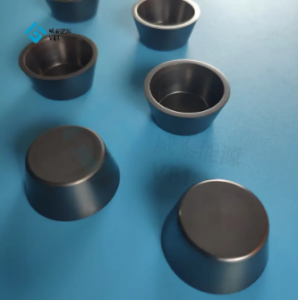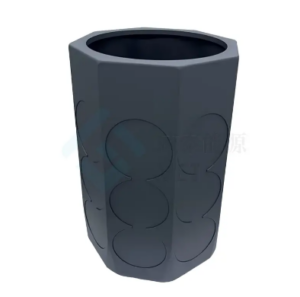
カーボン複合材料は、優れた熱的・機械的特性を持つ材料として際立っています。その高い熱伝導率は効率的な熱伝達を保証し、低い熱膨張率は過酷な条件下での寸法安定性を提供する。これらの複合材料の優れた強度は、炭素原子間の強力な共有結合によるものです。高度な製造技術により、その性能はさらに向上している。これらの特性により、炭素複合材料は、厳しい環境下での耐久性と信頼性が要求される用途に不可欠なものとなっています。
要点
- 炭素-炭素複合材料は熱伝導性と寸法安定性に優れ、高温用途に理想的です。
- 熱膨張係数が低いため、極端な高温下でも形状の変化が少なく、重要な環境での信頼性が向上します。
- 炭素-炭素複合材料のユニークな構造は、機械的強度を維持し、摩耗に耐えることを可能にし、航空宇宙やエネルギーのような要求の厳しい用途に適している。
- 熱分解や炭化を含む高度な製造技術は、これらの複合材料の特性を大幅に向上させ、最適な性能を保証する。
- 繊維の種類や配置をカスタマイズすることで、エンジニアは炭素-炭素複合材を特定の用途に合わせて調整し、その効果を最大限に高めることができる。
- 熱処理などの後処理は、炭素-炭素複合材料の強度と靭性を向上させ、応力下での長期耐久性を保証する。
- エレクトロニクスやロボット工学などの分野での新たな応用は、現代工学における炭素-炭素複合材料の継続的な革新と多様性を浮き彫りにしている。
炭素-炭素複合材料の熱特性
高い熱伝導性
熱伝達における炭素繊維とマトリックスの役割
炭素炭素複合材料は、炭素繊維と炭素マトリックスとの相乗的相互作用により、卓越した熱伝導性を示す。高い熱伝導率で知られる炭素繊維は、熱伝達の効率的な経路として機能します。炭素マトリックスは、複合材構造全体に均一な熱分布を確保することでこれを補完する。これらの要素が組み合わさることで、厳しい条件下でも熱を効果的に伝えることができる素材が生まれる。
熱性能に及ぼす密度と微細構造の影響
炭素複合材料の密度と微細構造は、その熱性能に大きく影響する。密度が高ければ、ボイドが減少し、繊維とマトリックスの接触が改善されるため、熱伝導率が向上する。均一な繊維配列と最小限の欠陥を特徴とする最適化された微細構造は、熱伝達効率をさらに高めます。エンジニアは、高度な用途における特定の熱要件を満たすために、これらのパラメータを調整することがよくあります。
低熱膨張係数(CTE)
高温での寸法安定性を支えるメカニズム
カーボン炭素複合材料は、その低熱膨張係数(CTE)により、高温下でも寸法安定性を維持します。炭素原子間の強い共有結合が熱変形に抵抗し、膨張や収縮を最小限に抑えます。この特性により、極端な熱にさらされても、材料はその形状と構造的完全性を保つことができる。このような安定性は、精密さと信頼性が要求される用途にとって極めて重要である。
他の高性能素材との比較
他の高性能素材と比較して、カーボン炭素複合材料は優れた熱安定性を示す。アルミニウムや鋼鉄のような金属は熱で大きく膨張し、構造上の問題につながる可能性がある。セラミックは、安定性は高いものの、動的環境に必要な靭性に欠けることが多い。カーボン複合材料は、低熱膨張率と優れた機械的特性を兼ね備えているため、高温用途に適しています。
極端な温度での耐熱性
3000°F(1650°C)以上の安定性と性能
カーボン炭素複合材料は、3000°F(1650°C)を超える環境で優れた性能を発揮します。強力な炭素-炭素結合で強化されたそのユニークな構造は、そのような極限状態での劣化を防ぎます。高温で弱くなったり溶けたりする多くの材料とは異なり、これらの複合材料は機械的および熱的特性を保持します。この弾力性により、高熱に耐える材料を必要とする産業には欠かせないものとなっている。
高温環境でのアプリケーション
カーボン複合材料は極端な温度にも耐えることができるため、高温環境下で広く使用されるようになった。耐熱性が重要なロケットノズルやヒートシールドのような航空宇宙部品には不可欠である。エネルギー分野では、原子炉や太陽熱システムで重要な役割を果たしています。その比類ない性能は、これらの厳しい用途における信頼性を保証します。
炭素-炭素複合材料の機械的特性
高い引張強度と弾性率
炭素繊維とマトリックス結合の貢献
炭素複合材料の引張強度と弾性率は、炭素繊維と周囲のマトリックスとの強固な相互作用に由来する。固有の強さで知られる炭素繊維は、主要な耐荷重能力を提供します。これらの繊維を結合するマトリックスは、複合材料全体の応力分布を確実にします。繊維とマトリックスの間のこの相乗効果は、変形することなく大きな引張力に耐える材料の能力を高めます。エンジニアはしばしば、要求の厳しい用途のために、これらの機械的特性を最大化するために結合プロセスを最適化します。
繊維配向と微細構造の影響
複合材料内の繊維の配向は、その機械的性能を決定する上で重要な役割を果たす。整列した繊維は、その軸に沿って優れた引張強さを示し、特定の荷重支持方向において非常に効果的な材料となる。逆に、ランダムな繊維配向は、より均一な強度をもたらしますが、目標とする方向におけるピーク性能を低下させる可能性があります。繊維の密度と配置を含む微細構造は、弾性率にさらに影響を与えます。よく設計された微細構造は欠陥を最小限に抑え、応力下での一貫した機械的挙動を保証します。
耐破壊性と靭性
応力下での割れや衝撃に対する耐性
カーボン炭素複合材料は、大きな応力下でも、ひび割れや衝撃に対して顕著な耐性を示します。炭素原子間の強い共有結合が亀裂の伝播を防ぎ、材料の構造的完全性を維持します。さらに、マトリックスが衝撃によるエネルギーを吸収・再分配し、壊滅的な破壊の可能性を低減します。この特性の組み合わせにより、この素材は耐久性と信頼性が最優先される用途に理想的なものとなっている。
靭性と耐久性に影響を与える要因
炭素複合材料の靭性と耐久性にはいくつかの要因が影響する。繊維とマトリックスの界面の質は極めて重要な役割を果たし、強固な結合は亀裂の発生と進展に抵抗します。繊維の種類と配置も、破壊せずにエネルギーを吸収する材料の能力に影響します。熱処理などの後加工技術は、微細構造を微細化することで靭性をさらに向上させます。これらの要素が総合的に、厳しい環境における複合材料の長期性能を保証します。
疲労と耐摩耗性
繰り返し荷重下での長期性能
カーボン炭素複合材料は、繰り返し荷重条件下での機械的特性の維持に優れています。この材料の耐疲労性は、繰り返される応力サイクルの中でエネルギーを散逸させ、微細構造の損傷に抵抗する能力から生まれます。従来の多くの材料とは異なり、カーボン複合材料は、変動する荷重に長時間さらされた後でも、劣化が最小限に抑えられます。この特性は、長期間にわたって安定した性能を必要とする用途における信頼性を保証します。
高ストレス環境での耐摩耗性
カーボン複合材料の耐摩耗性は、高ストレス環境に適しています。この材料の硬度と構造的完全性は、研磨条件下でも表面の劣化を防ぎます。マトリックスは繊維を外力との直接接触から保護し、摩耗を減らして複合材料の寿命を延ばします。この特性は、部品が継続的な摩擦や機械的ストレスに直面する産業で特に価値があります。
製造方法と特性への影響
熱分解と炭化プロセス
炭素マトリックスの形成と特性への影響
熱分解と炭化のプロセスは、炭素炭素複合材料内の炭素マトリックスを形成する上で極めて重要な役割を果たす。熱分解では、有機前駆体が不活性雰囲気中で熱分解を受け、炭素リッチな構造が残る。このステップにより、複合材料のマトリックスの基礎が確立される。続いて炭化が行われ、炭素以外の元素を除去して炭素含有量を高めることにより、材料がさらに精製される。こうして出来上がったマトリックスは、複合材料に特徴的な強度と熱安定性を与えます。よく形成された炭素マトリックスは、均一な応力分布を保証し、過酷な条件に耐える材料の能力に貢献します。
熱伝導率と機械的強度への影響
炭素複合材料の熱伝導性と機械的強度は、熱分解と炭化のプロセスの質に大きく依存する。これらの段階で高温になると、炭素原子の配列が改善され、より整然とした構造が形成される。この整列が熱伝達経路を強化し、優れた熱伝導性をもたらす。さらに、炭化の過程で不純物が取り除かれることで、マトリックス内の結合が強化され、複合材料の機械的弾力性が高まる。エンジニアはこれらの工程を注意深く制御し、特定の用途向けに複合材の性能を最適化している。
繊維プリフォームの役割
特定の用途向けにファイバーの種類や配置をカスタマイズ可能
ファイバー・プリフォームはカーボン複合材料のバックボーンとして機能し、多様な用途のニーズを満たすカスタマイズの機会を提供します。エンジニアは、引張強度や熱伝導率などの所望の特性に基づいて繊維の種類を選択します。例えば、高弾性繊維は卓越した剛性を提供し、高強度繊維は耐荷重性を向上させます。これらの繊維の配置は、一方向繊維、織物繊維、ランダム繊維のいずれであっても、複合材料の性能をさらに調整します。このようなカスタマイズにより、材料は航空宇宙やエネルギーのような産業の正確な要求を満たすことができる。
熱的・機械的性能の最適化
繊維プリフォームの最適化は、カーボン炭素複合材料の熱的・機械的性能に直接影響します。整列した繊維は、特定の方向に沿って熱伝導と引張強度を最大化し、この材料をターゲットとする用途に理想的なものにします。逆に、多方向配列はバランスの取れた特性を提供し、均一な性能を必要とする環境に適しています。エンジニアはまた、全体的な耐久性を高めるため、プリフォーム内のボイドや欠陥を最小限に抑えることにも注力しています。このような努力により、複合材料は厳しい条件下でも安定した結果を出すことができるのです。
後処理のテクニック
特性向上のための熱処理と高密度化
熱処理や高密度化などの後処理技術は、カーボン炭素複合材料の特性を著しく向上させる。熱処理は複合材を高温にさらすことで、炭素原子の整列を改善し、残留応力を減少させます。このプロセスにより、熱伝導性と機械的強度の両方が向上する。高密度化は、含浸と炭化の繰り返しによって達成され、マトリックス内の空隙を埋める。その結果、より密度が高く、過酷な環境にも耐えうる堅牢な素材となる。
強度、靭性、熱安定性の向上
後加工法は、炭素複合材料の強度、靭性、熱安定性の顕著な向上に寄与する。熱処理は微細構造を微細化し、亀裂の発生と伝播の可能性を低減する。高密度化は、弱点をなくすことで材料の耐摩耗性と耐疲労性を向上させる。これらの強化により、高応力・高温条件下でも複合材の完全性が維持される。産業界は、現代工学の厳しい要求を満たす材料を製造するために、これらの高度な技術に依存しています。
炭素-炭素複合材料の実用化
航空宇宙産業
ロケットノズル、ヒートシールド、再突入機への使用
航空宇宙産業は、重要な部品にカーボン炭素複合材を多用している。推進時の極端な温度と高圧に耐えるロケットノズルは、この材料の高い耐熱性と機械的強度の恩恵を受けている。大気圏再突入時に宇宙船を保護するために不可欠なヒートシールドは、3000°F(1650℃)を超える温度に耐えるためにこの複合材を利用している。再突入機もまた、厳しい熱的・機械的ストレスのもとで構造的完全性を維持するためにカーボン炭素複合材を使用しています。これらの用途は、最も要求の厳しい環境でも確実に機能する材料の能力を際立たせている。
軽量高温部品における利点
カーボン炭素複合材料は、軽量特性と高温性能のユニークな組み合わせを提供します。その低密度は、航空宇宙コンポーネントの総重量を減らし、燃料効率と積載量を向上させます。同時に、極端な高温下でも強度と安定性を維持できるため、耐久性と安全性も確保できる。この二重の利点により、性能と効率が最重要視される現代の航空宇宙工学には欠かせないものとなっている。
エネルギー部門
原子炉および太陽熱システムへの応用
エネルギー分野では、炭素複合材料は先進システムで重要な役割を果たしている。原子炉では、放射線損傷に強く、高温下でも安定性を維持できることから、これらの材料が制御棒や構造部品に使用されている。太陽光を集光して熱を発生させる太陽熱システムは、この材料の優れた熱伝導性と熱衝撃への耐性を利用している。これらの用途は、エネルギー生産の課題に取り組むカーボン炭素複合材料の多様性を示している。
熱管理とエネルギー効率における利点
効率的な熱管理はエネルギー・システムの最適化にとって極めて重要であり、カーボン炭素複合材料はこの分野で優れている。その高い熱伝導率は効率的な熱伝達を保証し、重要なプロセスにおけるエネルギー損失を低減します。さらに、熱膨張係数が低いため、熱応力が最小限に抑えられ、部品の寿命と信頼性が向上します。エネルギー効率とシステム性能を向上させることで、これらの複合材料は持続可能なエネルギー・ソリューションに貢献します。
その他の先端工学分野
自動車レース、工業用工具、医療機器への使用
カーボン炭素複合材は、航空宇宙やエネルギー以外の分野にも応用されている。自動車レースでは、ブレーキディスクやクラッチに使用され、その耐摩耗性と熱安定性により、過酷な条件下でも安定した性能を発揮する。工業用工具は、この材料の強度と耐久性の恩恵を受けており、高精度の製造工程に理想的である。医療分野では、カーボン炭素複合材料は、その生体適合性と軽量性により、手術器具や人工装具に利用されています。このような多様な用途は、この素材が産業全体に適応できることを裏付けている。
最先端技術における新たなアプリケーション
技術の進歩に伴い、カーボン炭素複合材料の新たな用途が生まれ続けている。研究者たちは、その熱的・電気的特性がデバイスの性能を向上させる可能性のある次世代エレクトロニクスにおける可能性を探っている。また、量子コンピューティングや先端ロボット工学への応用も研究されており、そのユニークな特性は画期的な進歩をもたらす可能性がある。これらの開発は、カーボン炭素複合材料を取り巻く現在進行中の技術革新と、最先端技術におけるその役割の拡大を浮き彫りにしている。
カーボン炭素複合材料は、卓越した熱的・機械的特性を発揮し、現代のエンジニアリングに欠かせないものとなっています。その高い熱伝導率は効率的な熱伝達を可能にし、低い熱膨張率は過酷な条件下での安定性をもたらします。これらの特性は、そのユニークな構造と高度な製造技術に起因しています。航空宇宙やエネルギーなどの産業では、これらの材料が重要な用途に使用されています。技術の進歩に伴い、カーボン炭素複合材料の需要は増加し続けるだろう。高性能エンジニアリングにおけるその役割は、技術革新の未来を形作る上でその重要性を確固たるものにしている。
よくあるご質問
炭素-炭素複合材料は何でできているのか?
炭素-炭素複合材料は、炭素マトリックスに埋め込まれた炭素繊維で構成されている。繊維は強度と剛性を提供し、マトリックスは構造の完全性を確保し、応力を分散させる。どちらの成分も、熱分解や炭化などのプロセスを通じて有機前駆体から得られる。
極端な温度下での炭素-炭素複合材料の性能は?
炭素-炭素複合材料は、3000°F(1650°C)を超える温度でも機械的および熱的特性を維持します。強力な共有結合とユニークな構造が劣化を防ぎ、ロケットノズルや熱シールドなどの高温用途に最適です。
なぜ炭素-炭素複合材料は特定の用途において金属よりも好まれるのか?
炭素-炭素複合材料は、いくつかの点で金属よりも優れている。熱膨張率が低く、熱下での寸法安定性が確保される。軽量であるため、システム全体の重量を軽減し、優れた耐熱性により、金属では故障する可能性のある過酷な条件にも耐えることができます。
炭素-炭素複合材料は摩耗や疲労に耐えられるか?
そう、炭素-炭素複合材料は優れた耐摩耗性と耐疲労性を発揮する。その堅牢な構造は、研磨条件下での表面劣化を防ぎ、エネルギーを放散する能力は、繰り返し荷重による損傷を最小限に抑えます。これらの特性は、厳しい環境下での長期的な信頼性を保証します。
繊維配向は炭素-炭素複合材料の特性にどのような影響を与えるのか?
繊維配向は複合材料の性能に大きく影響する。整列した繊維は、特定の方向に沿って引張強度と熱伝導率を高めます。ランダムまたは多方向配列はバランスの取れた特性を提供し、均一な強度を必要とする用途に適しています。
炭素-炭素複合材料が最も恩恵を受ける産業は?
航空宇宙、エネルギー、自動車レース、先端製造などの産業は、炭素-炭素複合材料から大きな恩恵を受けている。その高温安定性、強度、耐久性により、ロケット部品、原子炉、高性能ブレーキシステムなどの用途に欠かせないものとなっている。
炭素-炭素複合材料は環境的に持続可能か?
炭素-炭素複合材料の製造にはエネルギー集約的な工程が必要であり、環境問題が懸念される。しかし、その耐久性と長い寿命は、頻繁な交換の必要性を減らし、長期的には資源効率に貢献する。
後処理技術は炭素-炭素複合材料をどのように改善するのか?
熱処理や高密度化のような後処理技術は、炭素-炭素複合材料の特性を向上させる。熱処理は炭素原子を整列させ、強度と熱伝導性を向上させます。高密度化は空隙を埋めることで密度と靭性を高め、過酷な条件下でも優れた性能を発揮します。
炭素-炭素複合材料が航空宇宙用途に適しているのはなぜか?
炭素-炭素複合材料は、軽量特性と卓越した熱的・機械的性能を兼ね備えています。極端な温度と圧力に耐えるため、ロケットノズル、熱シールド、再突入機構造などの重要な航空宇宙部品に最適です。
炭素-炭素複合材料の新たな用途はありますか?
そう、研究者たちはエレクトロニクス、量子コンピューティング、ロボット工学などの分野で炭素-炭素複合材料の新たな用途を模索している。そのユニークな熱的、機械的、電気的特性は、最先端技術の有望な候補となっている。






